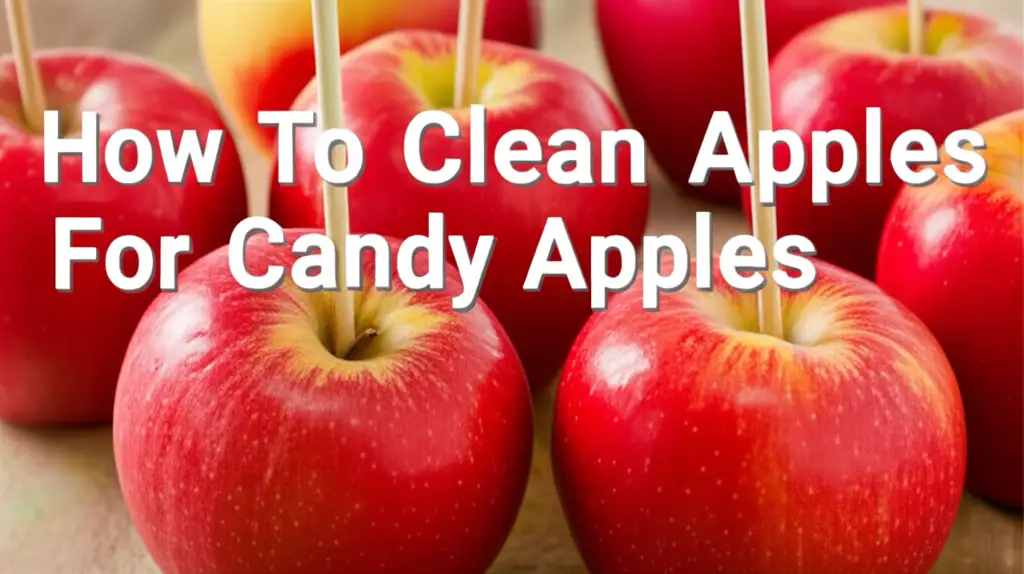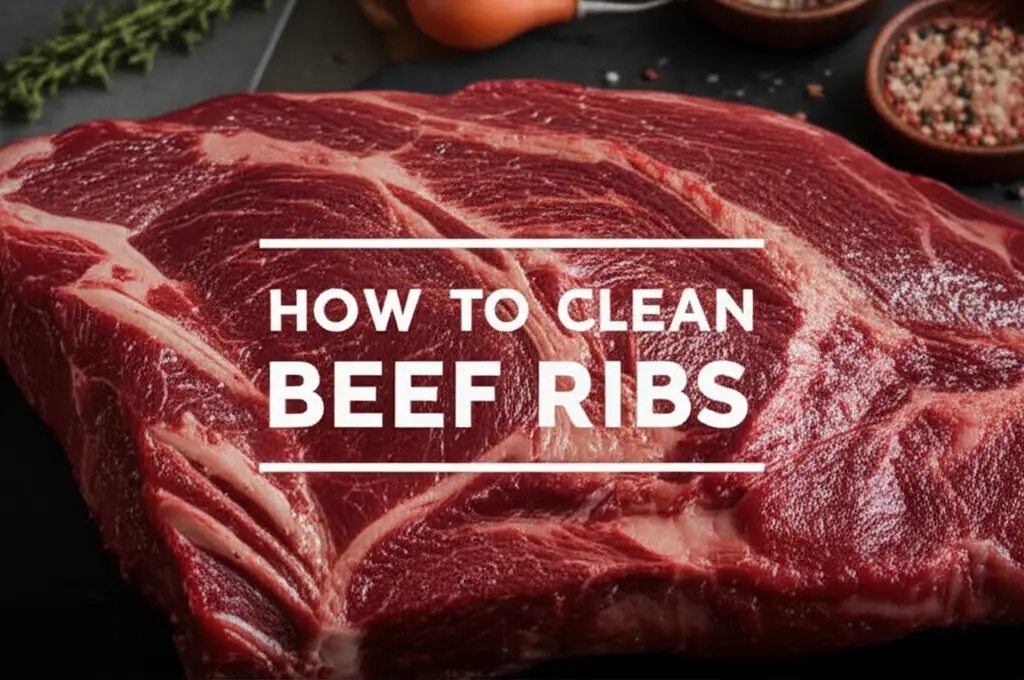· Food Preparation · 12 min read
How To Clean Apples For Candy Apples

Mastering the Clean: How To Clean Apples For Candy Apples
Making candy apples brings joy. These glossy, crisp treats are a classic delight. Many people wonder how to clean apples for candy apples correctly. Proper apple cleaning is vital for both food safety and candy adhesion. It ensures your candy coating sticks well and your treats are safe to eat.
This guide will show you exact steps for cleaning apples. We cover removing wax and dirt. We also share tips for a perfect candy apple surface. You will learn about essential tools and common mistakes. By the end, you will prepare apples like a pro. Your candy apples will look amazing and taste even better.
Takeaway
Cleaning apples for candy apples ensures a safe, perfectly coated treat.
- Remove wax and pesticides using hot water and a scrubbing brush.
- Use a vinegar and baking soda solution for a deeper clean.
- Dry apples completely before dipping to ensure candy sticks.
- Chill apples after cleaning for best candy adhesion.
To clean apples for candy apples, wash them thoroughly in hot water, scrubbing to remove wax and residues. A mixture of vinegar and baking soda helps remove stubborn films. Rinse apples completely and dry them perfectly with a clean cloth. This process ensures the candy coating adheres smoothly and stays crisp.
Why Proper Apple Cleaning Matters for Candy Apples
Properly cleaning apples is the first critical step for making excellent candy apples. Many people overlook this stage. It directly affects the quality and safety of your final product. Apples often come with a protective wax coating. This wax prevents moisture loss and enhances shine. This wax also keeps candy from sticking.
Beyond wax, apples carry residues. These include pesticides, dirt, and even handling oils. You do not want these on your sweet treat. A good clean removes all unwanted elements. This ensures a safe snack. It also creates a clean surface. Your candy coating will adhere smoothly. Skipping this step can result in a messy, sticky, and unappealing candy apple. Clean apples make candy apples successful.
Essential Tools and Ingredients for Apple Cleaning
You need only a few simple items to clean apples for candy apples. These items are likely already in your kitchen. Gathering them before you start makes the process smooth. Having everything ready saves time. It also helps you clean apples effectively.
First, you need a sturdy scrub brush. A vegetable brush works well. Its bristles can remove tough wax and dirt. Second, you need hot water. Very warm water helps melt away wax. Cold water will not do the job as well. Third, gather some white vinegar. Vinegar is a natural disinfectant and helps break down residues. Fourth, get some baking soda. How to clean with vinegar and baking soda methods are very effective for cleaning food. Baking soda acts as a gentle abrasive. It helps scrub away impurities. Finally, have clean paper towels or a lint-free cloth ready. These are for drying your apples completely.
Supplies Checklist:
- Large bowl or clean sink: For washing apples.
- Sturdy scrub brush: A vegetable brush or a clean sponge with a scrubbing side.
- White vinegar: A natural cleaner and disinfectant.
- Baking soda: Helps break down wax and pesticides. How to clean strawberries with baking soda uses a similar approach.
- Hot water: Essential for melting wax.
- Clean paper towels or lint-free cloth: For drying.
Using these simple tools and ingredients ensures your apples are perfectly prepared. They will be ready for a smooth candy coating. This attention to detail improves your candy apple results.
Step-by-Step Guide to Cleaning Apples for Candy Apples
Cleaning apples for candy apples involves more than just a quick rinse. Following a clear sequence of steps helps you achieve the best results. This method ensures all unwanted substances disappear. It prepares the apple surface for perfect candy adhesion. I find this process simple and effective every time.
Initial Rinse
Begin by rinsing each apple under running water. Use cool or lukewarm water for this first step. This washes away loose dirt and debris. It removes any obvious surface grime. This is just a preliminary rinse, not the deep clean. Make sure to rotate each apple. Get all sides wet.
Warm Water Wash
Next, fill a large bowl or a clean sink with very hot water. The water should be as hot as your hands can comfortably stand. Place your apples into this hot water. Let them soak for 10-20 seconds. This brief soak helps to soften the wax coating on the apples. You might even see a cloudy film appear on the water. This indicates wax coming off.
Vinegar and Baking Soda Soak (Optional but Recommended)
For a deeper clean, consider a vinegar and baking soda soak. After the hot water wash, drain the water. Refill the bowl with fresh warm water. Add 1 cup of white vinegar and 1-2 tablespoons of baking soda to the water. The mixture will fizz. Place the apples back into this solution. Let them soak for another 5-10 minutes. This mixture helps to break down stubborn wax and pesticides. It also acts as a natural sanitizer.
Thorough Scrub
Now it is time to scrub each apple individually. Take one apple at a time. Use your sturdy scrub brush. While holding the apple under hot running water, scrub its entire surface. Apply firm pressure. Pay special attention to the top and bottom indentations. These areas often trap more dirt and wax. You are aiming to remove all visible residue and make the apple skin feel squeaky clean. This step is where most of the cleaning happens.
Final Rinse
After scrubbing each apple, give it a final thorough rinse under hot running water. This washes away any remaining vinegar, baking soda, wax, or dirt. Make sure no soapy or gritty residue remains. The apple surface should feel completely clean and free of any slippery film. A perfectly rinsed apple is crucial for good candy adhesion.
Drying Completely
This is arguably the most critical step for perfect candy apples. Any moisture left on the apple surface will prevent the candy from sticking. It will cause the candy to slide right off. Use a clean, lint-free cloth or paper towels. Dry each apple meticulously. Rub firmly to absorb all water. You can also let the apples air dry on a wire rack for 30 minutes to an hour. For best results, after drying, place the apples in the refrigerator for at least 15-30 minutes before dipping. Chilling the apples helps the candy set faster and creates a crispier coating.
Following these steps ensures your apples are pristine. They will be ready for a beautiful, smooth candy coating. Your efforts here will pay off with delicious results.
The Importance of Removing Apple Wax (and How To Do It)
Many commercial apples have a thin, food-grade wax coating. This wax preserves freshness and makes apples look shiny. While safe to eat, this wax is a major problem for candy apples. Candy coating simply cannot stick to a waxy surface. It will slide right off. Removing this wax is a key part of the cleaning process.
The best way to remove apple wax is through heat and friction. Hot water helps soften the wax. As you saw in the previous section, a brief soak in very hot water begins this process. This makes the wax more pliable. Then, physical scrubbing finishes the job. Using a brush with firm bristles, you can effectively abrade the softened wax layer. This creates a rougher surface. This textured surface is perfect for candy to grip onto.
Some natural waxes exist on apples. These are less problematic than commercial wax. However, removing them also improves adhesion. The vinegar and baking soda solution aids in breaking down both natural and artificial waxes. This combination helps lift the waxy film. A thorough scrub ensures no wax remains. Always aim for a completely wax-free surface. This ensures your hard work making the candy pays off.
Drying Apples: A Critical Step for Perfect Candy Adhesion
Drying apples completely is non-negotiable for successful candy apples. This step is often underestimated. Many people think a quick towel dry is enough. However, even small amounts of moisture can ruin your candy coating. Water acts as a barrier between the apple and the candy. If water is present, the candy will not adhere properly. It will slide, clump, or create an uneven coating.
After washing and scrubbing, use a clean, lint-free cloth. I often use several paper towels to ensure thorough drying. Rub each apple until its surface feels completely dry. Pay close attention to the stem and bottom areas. Water can easily collect there. You want the apple surface to be slightly tacky, not slick. This tacky texture comes from a perfectly dry, wax-free skin.
Some people air dry their apples on a wire rack for 30 minutes or more. This allows any residual moisture to evaporate. For an extra measure, chill the dried apples in the refrigerator. Place them in the fridge for 15-30 minutes. Cold apples help the hot candy coating set faster. This creates a crispier shell. It also reduces the chance of candy slipping. A perfectly dry and chilled apple provides the ideal canvas for your delicious candy coating.
Common Mistakes to Avoid When Cleaning Apples
Making candy apples is fun, but simple cleaning errors can lead to sticky situations. Knowing what not to do is as important as knowing what to do. Avoid these common mistakes for the best results. Your candy apples will thank you for it.
First, do not use cold water for cleaning. Cold water hardens wax. It makes wax removal much harder. Always use very hot water to soften the wax. This prepares the apple surface for scrubbing. Second, do not skip the scrubbing. A simple rinse is not enough. Apples need a good scrub with a brush to remove wax and pesticides. Your fingers alone cannot do this effectively.
Third, never use dish soap or harsh cleaners on your apples. These products are not food-safe. They can leave chemical residues that are harmful. Stick to natural cleaners like vinegar and baking soda. Fourth, do not neglect drying. This is a very common mistake. Even a small drop of water will prevent candy from sticking. Take your time to dry each apple completely. Finally, do not clean apples too far in advance. Clean them a few hours before dipping. Apples can re-form a waxy film over time, or collect dust. Freshly cleaned apples work best. Avoiding these pitfalls makes your candy apple journey much smoother.
Selecting the Right Apples for Candy Apples
Choosing the correct apple variety is just as important as cleaning it. Not all apples make good candy apples. The right choice affects texture, flavor, and how well the candy sticks. I always recommend specific types for the best outcome. This ensures your hard work in cleaning pays off.
Look for apples that are firm and crisp. Softer apples can become mushy under the candy coating. They also might not hold the stick well. Firmness is key for a satisfying bite. Green apples, specifically Granny Smith, are a popular choice. Their tartness provides a great contrast to the sweet candy. This balance of flavors makes for a more enjoyable treat. Granny Smith apples also tend to be naturally firmer.
Choose medium-sized apples. Very large apples are hard to eat and dip. Small apples can be fiddly to handle. A medium size is perfect for individual portions. It also allows for easier dipping and handling. Inspect apples for bruises or soft spots. Damaged areas can ruin the candy coating. They can also lead to faster spoilage. Fresh, firm, and blemish-free apples make the best canvas for your candy creations. This careful selection, combined with proper cleaning, sets the stage for perfect candy apples.
FAQ Section
Can I use dish soap to clean apples for candy?
No, do not use dish soap. Dish soap contains chemicals not intended for food consumption. It can leave residues on the apple skin. Stick to natural and food-safe cleaning agents. Vinegar and baking soda are ideal. They clean effectively without leaving harmful substances.
How long do I need to dry apples before dipping?
You need to dry apples until they are completely free of moisture. This usually takes 5-10 minutes of thorough towel drying per apple. For extra assurance, let them air dry on a wire rack for 30 minutes. Any moisture causes the candy to slide off.
What kind of vinegar is best for cleaning apples?
White vinegar is the best choice for cleaning apples. It is inexpensive and widely available. Its acetic acid content helps break down wax and acts as a natural disinfectant. Avoid apple cider vinegar or balsamic vinegar; they can leave behind color or scent.
Why does candy slide off my apples?
Candy slides off your apples mainly due to two reasons: wax and moisture. If you do not remove the natural or artificial wax coating, the candy cannot adhere. Also, any water on the apple surface will prevent the candy from sticking. Ensure thorough cleaning and complete drying.
Do all apples have wax?
Most commercially sold apples have a food-grade wax coating applied after harvest. This coating protects the fruit. Even organic apples may have natural waxes or a light plant-based wax. Assume all apples need wax removal for candy apple preparation.
Can I clean apples ahead of time?
You can clean apples a few hours before dipping. Store them in the refrigerator on a clean surface. However, cleaning them too far in advance is not recommended. Apples can re-form a natural waxy film over time, or collect dust. For best adhesion, clean and dry them just before use.
Conclusion
Creating delightful candy apples begins with one crucial step: proper apple cleaning. We explored why this process matters. It ensures food safety and perfect candy adhesion. You now understand the role of wax removal. You also know the importance of complete drying. We covered essential tools like hot water, vinegar, and baking soda. Each step, from the initial rinse to the final chill, contributes to a flawless finish.
Remember, a clean apple surface makes all the difference. It prevents the candy from slipping. It also ensures a crisp, professional-looking treat. Avoid common mistakes like using cold water or skipping the scrub. Choose firm, medium-sized apples for the best results. By following these simple steps, you can confidently prepare apples. Your candy apples will be beautiful, delicious, and perfectly coated every time. Get ready to enjoy your perfectly prepared treats! Try these methods on your next batch of candy apples.
- candy apples
- apple cleaning
- food safety




